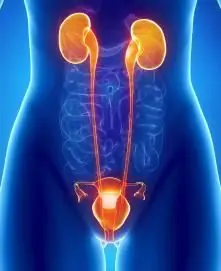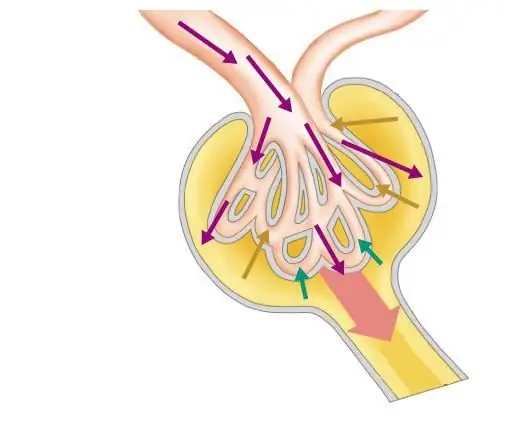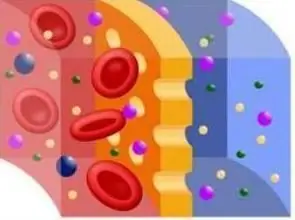- Author Curtis Blomfield [email protected].
- Public 2023-12-16 20:44.
- Last modified 2025-01-23 17:01.
Have you ever wondered what a titanic work our organs do every day to ensure the metabolism in the body? How and where is primary and secondary urine formed, what are the mechanisms of regulation of these complex processes, what happens to the body when they are disturbed? Let's take a closer look at these issues in this article.

Introduction
Metabolism is the only source of energy and nutrient substrates for all living organisms, including humans. And their main carrier is blood. However, in the process of metabolism, not only necessary, but also unnecessary, unnecessary or even toxic metabolites are formed, which must be released back into the environment. There are 4 ways for this: with air on exhalation, with skin secrets, through the intestines and kidneys. Here we will consider the last mechanism in more detail, because most of the proper metabolism in our body depends on it, and hence its provision with all the necessary substances.
What is the importance of the kidneys in the body?
The kidneys, as you know, are normal - this is a paired organ locatedextraperitoneally in the human lumbar region. It is this organ that is responsible for the excretion of all toxins and metabolites of the body that are in the blood and do not enter the bile, and for electrolyte balance. In addition, some hormones are synthesized in them and one of the main mechanisms for regulating blood pressure is located - the renin-angiotensin-aldosterone system, which, due to special juxtaglomerular cells in the afferent arteriole of the renal corpuscle, is very sensitive to this indicator. The parenchyma of this organ consists of millions of nephrons, in the capillary glomeruli of which the formation of primary urine occurs, and in the tubules - its concentration to the secondary.
What is it based on?

This process is multi-stage and is based on the concept of a gradient, that is, the difference between values. Thus, the pressure gradient between the afferent and efferent arterioles regulates the amount of urine excreted, and hence the value of the volume of circulating blood and blood pressure. And the concentration gradient of ions and the permeability of the walls of the tubules for them ensures the electrolyte balance in our body. Thus, the kidneys are a vital organ, as well as the only correct answer to the question: “How and where is the primary urine formed?” If we talk in more detail about the structure of the nephron, then two main parts are distinguished in it: the renal corpuscle (capillary glomerulus + external Bowman-Shumlyansky capsule) and tubules (descending - proximal convoluted straight line, loop of Henle, ascending - distal straight and convoluted). Likewhere is primary urine formed in this complex system? Pretty simple once you figure it out.
How does it work?

So, all processes take place precisely in the structures of the nephron through sequential mechanisms. In fact, primary urine is a liquid obtained by filtration from the cellular elements of the blood, and this happens in the renal corpuscle. Due to the fact that the diameter of the afferent arteriole of the nephron is twice the diameter of the efferent one, blood is pumped under high pressure into the Bowman-Shumlyansky capsule, and under the influence of the same force enters the capillary glomerulus. At the same time, cellular elements and coarse molecules do not pass through the barrier of the vessel walls, and thus they exit the capsule back along the efferent arteriole. Here is how and where primary urine is formed. And this process is repeated constantly, every second, because to maintain the viability of our organs and tissues, the blood circulates continuously, passing through the kidneys as well.
Some more details

Thus, per day this organ passes through itself up to 1700 liters of blood, from which primary urine (150-170 liters) is formed, that is, 1 liter out of every ten. At the same time, enough fluid must be excreted from the body, because every day a person consumes about 2-3 liters of water, plus an additional half liter is formed during metabolic processes. And since primary urine is obtained by the simplest filtration of blood through membranes, it is practically plasma, but withoutlarge molecules. But unlike the final urine, many ions and glucose are also included in the composition of the primary urine, since they easily penetrate through the vascular wall. Further, as it passes through the tubular system, it reabsorbs water, electrolytes and, most importantly, glucose. That is why, when protein and sugar are found in the urine test, the doctor will certainly suspect the pathological condition of the body.
Diseases
Kidneys are exposed to many infectious agents, their own antibodies, and parasites. So, a formidable disease is glomerulonephritis, which affects, first of all, the nephrons, where primary urine is formed. Further, the inflammatory process passes to the tubules, and therefore a large amount of protein and electrolytes are found in urine tests.

The most common pathology is pyelonephritis - inflammation of the pelvicalyceal system of an infectious nature, that is, the parts of the kidney that excrete urine into the ureter. In this case, the parenchyma suffers slightly, so the protein is found in small quantities, but bacteria and leukocytes are significant. In addition, nephritis of various nature occurs with systemic pathologies of the body (amyloidosis), diseases of the cardiovascular system (atherosclerosis, arterial hypertension, thrombosis), metabolic disorders. There are also congenital malformations of the urinary system. Thus, the kidneys are extremely susceptible to pathological changes, and since their role in the body is vitally high, then about their he althshould be taken care of from a young age.






